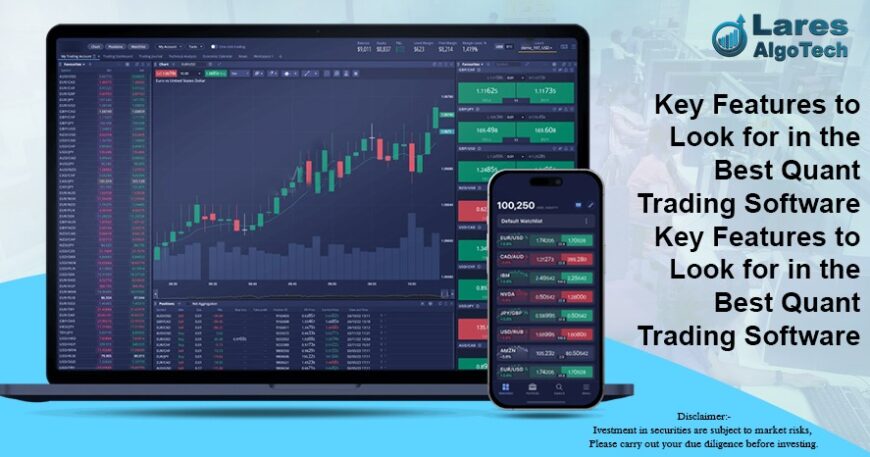
Quantitative trading (commonly referred to as quant trading) relies on sophisticated algorithms and advanced mathematical models to make trading decisions. As financial markets grow increasingly complex, having the right software is critical to implementing successful trading strategies. This article outlines the key features to look for when selecting the best quant trading software.
1. Introduction to Quant Trading Software
Quant trading involves using complex algorithms to identify trading opportunities across markets. Quantitative trading software facilitates this by offering tools to develop, backtest, and execute strategies in real time. With markets moving faster than ever, having advanced, reliable software ensures you can capitalize on opportunities swiftly and efficiently.
Quant software is essential for institutional traders and hedge funds, but retail traders are also increasingly adopting these platforms as they seek to stay competitive.
2. Importance of Choosing the Right Software
A quant trader’s success heavily depends on the tools at their disposal. Choosing the right software can help traders fine-tune their strategies, manage risk, and stay ahead in the fast-paced world of algorithmic trading. Subpar software could lead to inefficiencies, missed opportunities, and financial losses.
When selecting a quant trading platform, it’s essential to balance functionality, speed, and ease of use to ensure optimal trading outcomes.
3. Essential Features of Quant Trading Software
Not all quant trading platforms are created equal. Here are some core features that should be considered when selecting the right software:
Algorithm Development: A versatile development environment for coding and testing trading strategies.
Backtesting and Historical Data: Ability to test strategies against historical data.
Real-Time Data Integration: Access to live data streams.
Execution Speed: Low-latency trading capabilities for rapid order execution.
Risk Management Tools: Built-in features to manage risk and exposure.
4. Algorithm Development Environment
The heart of any quant trading software lies in its ability to support algorithm development. Look for platforms that offer:
- Support for Multiple Programming Languages: Python, R, and C++ are popular for algorithm development. Ensure the software integrates seamlessly with your preferred language.
- Pre-built Libraries and Functions: These help users create trading algorithms faster by offering commonly used models and calculations.
- Intuitive Interface for Non-Coders: For traders who are not fluent in programming, a drag-and-drop interface can help create algorithms without writing complex code.
- Access to Extensive Historical Data: Accurate and extensive data history helps test the strategies thoroughly.
- Simulated Trading: Simulate real market conditions to measure performance in varying scenarios.
- Performance Metrics: Tools to evaluate the success of backtested strategies, such as Sharpe ratio, maximum drawdown, and return on investment (ROI).
5. Real-Time Data Access and Integration
In quant trading, real-time data is crucial for staying ahead of the market. High-quality software should provide:
- Seamless Integration with Multiple Data Providers: The ability to access real-time data feeds from multiple sources, including stock exchanges, news agencies, and economic indicators.
- Real-Time Market Monitoring: Live monitoring of the markets allows for quick reaction to price changes or breaking news.
6. Strategy Optimization and Automation
Optimization tools in quant trading software are key to enhancing the performance of strategies. Look for features that enable:
- Automated Trading Execution: Once a strategy is optimized, the ability to execute trades without manual intervention is critical for reducing reaction times.
- Parameter Optimization: Software that supports multi-parameter testing to find the most effective settings for a given strategy.
7. Risk Management Tools
Managing risk is a fundamental aspect of successful quant trading. Your software should include:
- Stop-Loss and Take-Profit Functions: Automated mechanisms to exit trades at predefined loss or profit levels.
- Position Sizing Tools: Features that help determine how much capital to allocate per trade based on risk tolerance and market volatility.
- Volatility Analysis: Built-in tools to assess market volatility and adjust strategies accordingly.
8. Execution Speed and Latency
Fast execution is critical in quant trading, especially for high-frequency strategies. Look for software with:
- Low Latency Infrastructure: Trading platforms that operate close to the data centers of major exchanges can minimize execution delays.
- Direct Market Access (DMA): This ensures orders are placed directly on exchanges without intermediary brokers, reducing execution time.
9. Multi-Asset Support
Diversification is an important element in quant trading strategies. The best software should:
- Support Multiple Asset Classes: Stocks, forex, commodities, options, and cryptocurrencies.
- Cross-Asset Trading Capabilities: The ability to develop strategies that work across different markets.
10. Integration with Brokers and Exchanges
The ability to connect your quant trading software with your broker or exchange is essential. Consider:
- Broker API Integration: The software should seamlessly connect with major brokers and exchanges, allowing for efficient execution of trades.
- Support for Popular Trading Platforms: Compatibility with platforms like MetaTrader or NinjaTrader.
- Customization and Flexibility
Every quant trader has unique needs. Look for software that allows:
- Customizable Dashboards and Reports: Tailor data visualization and reporting to your specific requirements.
- Adaptability to Different Markets: Ensure the platform is flexible enough to accommodate strategies that work in various market conditions, from trending to range-bound environments.
-
Cost and Licensing Structure
Quant trading software ranges from open-source solutions to expensive proprietary platforms. When considering costs, evaluate:
- Subscription vs. One-Time License: Some platforms charge a monthly fee, while others require a one-time purchase.
- Hidden Costs: Be aware of additional fees for accessing premium features, data feeds, or broker integrations.
- Security and Data Protection
Since sensitive financial information is involved, robust security is a must. Look for:
- Encryption: Ensure the software uses strong encryption protocols to protect data.
- Secure API Access: API connections should be secure to prevent unauthorized access.
- Regular Security Updates: Software that is regularly updated to fix vulnerabilities.
- User Support and Community
Quant trading platforms can be complex, making user support and community engagement important. Ensure that:
- Customer Support is Readily Available: Whether through chat, phone, or email, reliable support is essential.
- Active User Community: A platform with an engaged community can provide valuable insights and shared strategies.
-
Compatibility with Cloud Computing
Cloud computing is transforming how traders work by offering scalability and accessibility. The best software should:
- Cloud-Based Backtesting and Optimization: Allows traders to run complex computations without the need for expensive hardware.
- Remote Access: Trade from anywhere using a cloud-based platform.
- AI and Machine Learning Integration
With AI playing an increasingly significant role in financial markets, the best quant trading software should:
- Machine Learning Algorithms: Use AI models to predict price movements and improve trade execution.
- Data Mining and Predictive Analytics: Integrate AI tools to analyze large datasets for more accurate trading decisions.
-
Mobile Trading and Remote Access
With modern technology, traders are no longer confined to their desks. Look for software with:
- Mobile Apps: The ability to monitor and execute trades on the go.
- Cross-Device Synchronization: Access to the platform across desktop, mobile, and tablet devices.
- Learning Curve and Educational Resources
Some quant trading software can be complex, requiring time to master. Make sure the platform offers:
- Comprehensive Documentation: Guides, FAQs, and detailed tutorials to help users learn the system.
- Educational Resources: Webinars, forums, and learning modules to improve trading skills.
- Future of Quant Trading Software
As technology continues to advance, so will quant trading software. Future trends to watch include:
- Increased AI Integration: As AI improves, trading platforms will become more predictive and less reliant on manual inputs.
- Greater Accessibility for Retail Traders: Expect platforms to become more user-friendly for non-institutional traders, democratizing access to powerful trading tools.
Selecting the best quant trading software is crucial for developing, testing, and executing trading strategies in an increasingly competitive market. By focusing on features such as real-time data access, backtesting capabilities, execution speed, risk management, and AI integration, traders can enhance their performance and mitigate risks. With advancements in technology, the future of quant trading looks bright, offering more tools and resources for both institutional and retail traders alike.
Frequently Asked Questions (FAQs)
- What is Quant Trading?
Quant trading uses algorithms and mathematical models to execute trades automatically, based on quantitative data. - Why is backtesting important in quant trading software?
Backtesting allows traders to test their strategies using historical data, helping them assess performance before risking real capital. - How do I choose the right quant trading software?
Look for features such as a user-friendly algorithm development environment, strong backtesting tools, real-time data access, and robust risk management. - What programming languages are commonly used in quant trading?
Python, R, and C++ are popular languages due to their flexibility, speed, and extensive libraries for algorithmic trading. - How does execution speed affect quant trading?
Fast execution is critical in quant trading, especially for high-frequency strategies, as it ensures trades are executed at the best possible prices. - Is quant trading software suitable for retail traders?
Yes, many platforms are designed for retail traders, offering intuitive interfaces, educational resources, and scalability.






 .facebook.com/lares.algotech
.facebook.com/lares.algotech  instagram.com/laresalgotech/
instagram.com/laresalgotech/  x.com/AlgoLares
x.com/AlgoLares  whatsapp.com/channel/...
whatsapp.com/channel/...  .linkedin.com/company/lares-algotech/
.linkedin.com/company/lares-algotech/  youtube.com/@LaresAlgoTech
youtube.com/@LaresAlgoTech